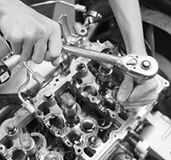Engineering and Technology Quarterly Reviews
ISSN 2622-9374




Published: 26 February 2020
Synthesis of Chalcones from Acetone and tetrazole and 2-acetyl naphthalene Assisted by Microwave
Bonyad Ali Moin
Bamyan University, Afghanistan

Download Full-Text Pdf
10.5281/zenodo.3686827
Pages: 16-22
Keywords: Tetrazolo, Quinoline, Acetone, Condensation, Microwave Irradiation And Chalcone
Abstract
In the present study, we understood the total synthesis one chalcone derivative via Claisen-Schmidt condensation of the respective aldehydes and ketones using Microwave assisted irradiation method. In the microwave environment, chemical reactions usually proceed faster and give higher yields with fewer by- products. In the synthesis, a common aldehyde namely tetrazolo {1, 5-a} quinoline-4-carbaldehyde was used while the ketones used were respectively acetone, 2- acetyl Naphthalene. The Chalcone synthesised from Tetrazolo {1, 5-a} quinolone-4-carbaldehyde and acetone was 4-(tetrazolo {1, 5-a} quinoline-4-yl) but -3-en-2-one. The Chalcone synthesised from Tetrazolo {1, 5-a} quinoline-4-carbaldehyde and 2-acetyl Naphthalene was 2E-1-(naphthalene-2-yl)-3-(tetrazolo {1, 5-a} quinolone-4-yl) prop-2-en-1- one. The starting aldehyde was Tetrazolo {1, 5-a} quinoline-4-carbaldehyde necessary for the Claisen-Schmidt condensation was in turn synthesized from Acetanilide which and Vilsmeier reagent (DMF and PoCl3) to produce the intermediate compound 2-chloroquinoline-3-carbaldehyde. This intermediate 2-chloroquinoline-3-carbaldehyde was then treated with sodium azide and acetic acid with ethanol as solvent to produce Tetrazolo {1, 5-a} quinoline-4-carbaldehyde. Structure of the compound were confirmed by spectral data such as IR and 1H-NMR.
References
- Affan, M. A., Siong W, F., Jusoh, I., Hanapi, S., Edward R.T. Teikink. (2009). Synthesis, Characterization and biological studies of organotin (5) complexes with hydraone ligand. Inorganica Chimica Acta. 362: 5031 -5037.
- Avila, H.P., Albino Smania, E. D. F., Monache, F. D., Smania Junior, A. (2008). Structure-activity relationship of antibacterial chalcones. Bioorganic & Medicinal Chemistry. 16: 9790-9794.
- Bennet, M., Burke. A. J., Ivo O’Sullivan, I, W. (1996). Aspects of the Algar- Flynn- Oyamada (AFO) Reaction. Tetrahedron. Vol. 52: 7163-7178.
- Black, W. B and Lutz, R. E. (1954). Ultraviolet Absorption Spectra of Chalcones. Identification of Chromophorses. 77: 5134-5140.
- Bohm, A. B. (998). Introduction to Flavonoids, Harwood Academic Pub, London, pg. 243-284.
- Chaudhuri, M. K., Khan, A. T., and Patel, B. K. (1998). An Environmentally benign synthesis of organic ammonium tribromides (OATB) and bromination of selected organic substrate by tetrabutylammonium tribromide (TBATB). Tet letts., 39: 8163-8166.
- Climet, M. J., Corma, A., Iborra, S., Velty, A. (2004). Activated hydrotalcites as catalyst for the synthesis of Chalcones of Pharmaceutical interest. J Catal. 221: 474-482.
- Dhar, D. N. and Jal, J.B. (1958). Chalcones: condensation of aromatic aldehydes with resacetophenone 2. Chalcone 2: 1159-1161.
- Edrari, S., Cotelle, N., Bakkaour, Y., Ronaldo, C. (2003). An efficient synthesis of Chalcones Based on the Suzuki Reaction. Tet. Letts. 44: 5359-5363.
- Fresneda P. M., Molina P., and Sanz M.A., Synlett, 2, 2001, 218.
- Fukie, K., Matsumoto, T., Nakamura, S., and Nakayama, M. (1968). Synthesis studies of the flavone derivativs. 7. The synthesis of Jaceidin. Bulletin of the Chemical Society of Japan.
- Ganguly, A., Mahat, P. K., Biswas, D., pramanik, B. N., Chan T. M. (2005). Synthesis and Propeties of 3-Acetyl-γ-pyrones, A Novel Class of Flavones and Chromones. Tet. Letts. 46: 4119-4121.
- Hampford Research Inc. (2009). Technical data sheet, dibromochalcone. {Brochure}. Stratford, CT.
- Jamil, S., Mohd Sirat, H., Jantan, I., Aimi, N., Kitajima, M. (2008). A new prenylated dihydrochalcone from the leaves of Artocarpus lowii, Journal of Natural medicine. 62: 321-324.
- Khajavi M. S., Moghadam K.R., and Hazarkhani H., synth. Commun. 29. 1999, 2617.
- Marins M.A.P., Beck P., Cunico W., Pereira C.M.P Sinhorin A.P., Blanco R.F., Peres R., Boncorso H.G., and Zanatta N., Tet. Lett. 43. 2002, 7005.
- Nakanishi, K. (1975). Natural Products Chemistry. 2. Tokyo: Kodansha Ltd. 225- 228.
- Petrov, O., Ivanova, Y., Gerova, M. (2008). SOCl2/EtOH: Catalytic system for synthesis of Chalcones. Catalysis Communication. 9: 3150316.
- Rajendra, V.R. (1999). Solvent-free organic synthesis using supported reagents and microwave irradiation. Green Chemistry. Pg.: 43-55.
- Srivastava, Y.K. Eco-friendly Microwave Assisted Synthesis of Some Chalcones. Rasayan J. chem. 1: 884-886.
- Zhou J.F., Hua Xue Yan Jiu Yu Ying Yong, 13, 2001,712.



